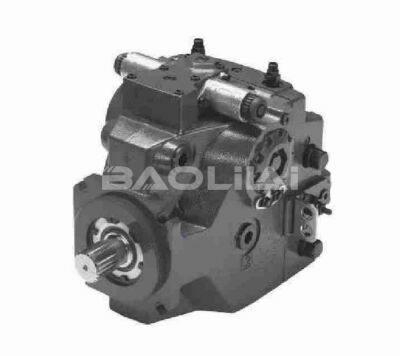Best practices and techniques for adjusting hydraulic pump operating parameters
Tuning the operating conditions of a hydraulic pump involves optimizing parameters to achieve the desired performance, efficiency and reliability. The following are general steps for adjusting the operating conditions of a hydraulic pump:
1. Understand the system requirements:
Determine the specific requirements of the hydraulic system. Consider factors such as flow, pressure and temperature.
2. Check the pump specifications:
Refer to the pump specifications and technical documentation for pump capabilities and limitations.
3. Monitor current operating status:
Use appropriate instrumentation to measure and monitor the current operating condition of the hydraulic pump. This includes parameters such as pressure, flow and temperature.
4. Adjust pump speed:
If the pump is variable speed, consider adjusting the speed to meet system needs. Higher velocities generally result in increased flow rates.
5. Adjust pressure settings:
Adjust the pump pressure settings based on system requirements. This can be done using a pressure control valve.
H1-P-078-L-A-A-A5-C2-N-F6-H-F1-H6-L-42-L-42-C-L-24-PN-NNN-NNN H1P078LAAA5C2NF6HF1H6L42L42CL24PNNNNNNN
H1-P-078-L-A-A-A5-C2-N-F6-H-F1-H6-L-42-L-42-C-L-20-PN-NNN-NNN H1P078LAAA5C2NF6HF1H6L42L42CL20PNNNNNNN
H1-P-078-L-A-A-A5-C2-N-F6-H-F1-H6-L-30-L-30-C-L-24-PN-NNN-NNN H1P078LAAA5C2NF6HF1H6L30L30CL24PNNNNNNN
H1-P-078-L-A-A-A5-C2-N-F5-H-G9-H6-K-35-K-35-C-P-24-PN-NNN-NNN H1P078LAAA5C2NF5HG9H6K35K35CP24PNNNNNNN
H1-P-078-L-A-A-A5-C2-N-F5-H-F1-H6-L-42-L-42-C-P-24-PN-NNN-NNN H1P078LAAA5C2NF5HF1H6L42L42CP24PNNNNNNN
H1-P-078-L-A-A-A5-C2-N-F4-H-G9-H6-L-25-L-25-F-M-24-PN-NNN-NNN H1P078LAAA5C2NF4HG9H6L25L25FM24PNNNNNNN
H1-P-078-L-A-A-A5-C2-N-F4-H-G1-H6-L-41-L-41-C-M-22-PN-NNN-NNN H1P078LAAA5C2NF4HG1H6L41L41CM22PNNNNNNN
H1-P-078-L-A-A-A5-C2-N-F4-H-G1-H6-L-35-L-35-C-N-20-PN-NNN-NNN H1P078LAAA5C2NF4HG1H6L35L35CN20PNNNNNNN
H1-P-078-L-A-A-A5-C2-N-F4-H-G1-H6-L-33-L-33-F-M-26-PN-NNN-NNN H1P078LAAA5C2NF4HG1H6L33L33FM26PNNNNNNN
H1-P-078-L-A-A-A5-C2-N-F4-H-G1-H6-L-28-L-28-C-M-24-PN-NNN-NNN H1P078LAAA5C2NF4HG1H6L28L28CM24PNNNNNNN
H1-P-078-L-A-A-A5-C2-N-F4-H-G1-H6-L-18-L-18-C-M-20-PN-NNN-NNN H1P078LAAA5C2NF4HG1H6L18L18CM20PNNNNNNN
H1-P-078-L-A-A-A5-C2-N-F4-H-G1-H6-L-15-L-35-C-M-24-PN-NNN-NNN H1P078LAAA5C2NF4HG1H6L15L35CM24PNNNNNNN
H1-P-078-L-A-A-A5-C2-N-D8-H-G9-H3-L-42-L-42-C-P-24-PN-NNN-NNN H1P078LAAA5C2ND8HG9H3L42L42CP24PNNNNNNN
H1-P-078-L-A-A-A5-C2-N-D8-H-G9-H3-L-35-L-35-C-P-24-PN-NNN-NNN H1P078LAAA5C2ND8HG9H3L35L35CP24PNNNNNNN
H1-P-078-L-A-A-A5-C2-N-D8-H-G9-H2-L-28-L-28-C-P-24-PN-NNN-NNN H1P078LAAA5C2ND8HG9H2L28L28CP24PNNNNNNN
H1-P-078-L-A-A-A5-C2-N-D8-H-G1-NN-L-42-L-42-C-P-24-PN-NNN-NNN H1P078LAAA5C2ND8HG1NNL42L42CP24PNNNNNNN
H1-P-078-L-A-A-A5-C2-N-D8-H-G1-NN-L-38-L-38-F-P-24-PN-NNN-NNN H1P078LAAA5C2ND8HG1NNL38L38FP24PNNNNNNN
H1-P-078-L-A-A-A5-C2-N-D8-H-G1-NN-L-38-L-38-C-P-24-PN-NNN-NNN H1P078LAAA5C2ND8HG1NNL38L38CP24PNNNNNNN
H1-P-078-L-A-A-A5-C2-N-D8-H-G1-NN-L-30-L-30-C-P-24-PN-NNN-NNN H1P078LAAA5C2ND8HG1NNL30L30CP24PNNNNNNN
H1-P-078-L-A-A-A5-C2-N-D8-H-G1-H5-L-38-L-38-C-P-24-PN-NNN-NNN H1P078LAAA5C2ND8HG1H5L38L38CP24PNNNNNNN
6. Optimize flow control:
Adjust the flow control valve to optimize flow through the system. This is critical to matching pump output to the requirements of the hydraulic system.
7. Check fluid level and condition:
Make sure the hydraulic fluid level is appropriate and the fluid is in good condition. Contamination or low fluid levels can affect pump performance.
8. Check and adjust the safety valve:
Check the safety valve and adjust if necessary. Pressure relief valves protect the system from overpressure conditions.
9. Check the filters:
Check and replace filters regularly to prevent contamination that could affect pump efficiency.
10. Evaluate Temperature Control:
Monitor the temperature of the hydraulic oil and adjust the cooling system if necessary. High temperatures can reduce the performance of pumps and other system components.
11. Consider load sensing:
If applicable, consider implementing a load sensing system to adjust pump output based on actual load requirements. This improves overall system efficiency.
12. Check and adjust pump control settings:
If the pump has electronic controls, check and adjust settings according to system requirements.
13. Perform system testing:
After adjustments, test to ensure the hydraulic system is operating within required parameters.

14.Documents:
Record any changes to pump settings and operating conditions for future reference.
15. Regular maintenance:
Develop a regular maintenance schedule to ensure your hydraulic pump continues to operate at its best.
16. Training and Skills Development:
Make sure operators and maintenance personnel are adequately trained and understand the hydraulic system and the adjustments that can be made. Skilled personnel can effectively respond to changing system needs and resolve issues in a timely manner.
17. Use feedback mechanisms:
Implement feedback mechanisms such as sensors and monitoring systems to continuously assess hydraulic pump performance. This data can be used to make informed adjustments and identify potential problems before they become serious.
18. Consider energy efficiency:
In addition to meeting system requirements, the energy efficiency of the hydraulic pump must also be considered. Optimize operating conditions to minimize energy consumption while maintaining efficient system performance.
19. Solve abnormal noise or vibration:
Unusual noise or vibration may indicate a problem with the hydraulic system. Investigate and resolve any unusual sounds or vibrations promptly to prevent damage to the pump and other components.
20. Implement preventive maintenance:
Develop and follow a preventive maintenance plan that includes regular inspections, lubrication and parts replacement. This proactive approach extends the life of the hydraulic pump and reduces the likelihood of unexpected failure.
H1-P-078-L-A-A-A5-C2-N-D8-H-G1-H5-L-35-L-35-C-P-24-PN-NNN-NNN H1P078LAAA5C2ND8HG1H5L35L35CP24PNNNNNNN
H1-P-078-L-A-A-A5-C2-N-D8-H-G1-H5-L-28-L-28-C-P-24-PN-NNN-NNN H1P078LAAA5C2ND8HG1H5L28L28CP24PNNNNNNN
H1-P-078-L-A-A-A5-C2-N-D8-H-G1-H3-L-38-L-38-C-P-24-PN-NNN-NNN H1P078LAAA5C2ND8HG1H3L38L38CP24PNNNNNNN
H1-P-078-L-A-A-A5-C2-N-D6-H-G9-NN-L-42-L-42-F-L-24-PN-NNN-NNN H1P078LAAA5C2ND6HG9NNL42L42FL24PNNNNNNN
H1-P-078-L-A-A-A5-C2-N-D6-H-G9-NN-L-42-L-42-C-L-24-PN-NNN-NNN H1P078LAAA5C2ND6HG9NNL42L42CL24PNNNNNNN
H1-P-078-L-A-A-A5-C2-N-D6-H-G9-NN-L-33-L-15-F-L-24-PN-NNN-NNN H1P078LAAA5C2ND6HG9NNL33L15FL24PNNNNNNN
H1-P-078-L-A-A-A5-C2-N-D6-H-G9-H5-L-42-L-42-C-L-30-PN-NNN-NNN H1P078LAAA5C2ND6HG9H5L42L42CL30PNNNNNNN
H1-P-078-L-A-A-A5-C2-N-D6-H-G9-H5-L-42-L-42-C-L-28-PN-NNN-NNN H1P078LAAA5C2ND6HG9H5L42L42CL28PNNNNNNN
H1-P-078-L-A-A-A5-C2-N-D6-H-G9-H5-L-42-L-42-C-L-24-PN-NNN-NNN H1P078LAAA5C2ND6HG9H5L42L42CL24PNNNNNNN
H1-P-078-L-A-A-A5-C2-N-D6-H-G9-H5-L-23-L-23-F-L-20-PN-NNN-NNN H1P078LAAA5C2ND6HG9H5L23L23FL20PNNNNNNN
H1-P-078-L-A-A-A5-C2-N-D6-H-G9-H3-L-42-L-42-C-L-30-PN-NNN-NNN H1P078LAAA5C2ND6HG9H3L42L42CL30PNNNNNNN
H1-P-078-L-A-A-A5-C2-N-D6-H-G9-H3-L-42-L-15-F-L-24-PN-NNN-NNN H1P078LAAA5C2ND6HG9H3L42L15FL24PNNNNNNN
H1-P-078-L-A-A-A5-C2-N-D6-H-G9-H2-L-42-L-42-F-L-24-PN-NNN-NNN H1P078LAAA5C2ND6HG9H2L42L42FL24PNNNNNNN
H1-P-078-L-A-A-A5-C2-N-D6-H-G9-H2-L-42-L-42-C-L-30-PN-NNN-NNN H1P078LAAA5C2ND6HG9H2L42L42CL30PNNNNNNN
H1-P-078-L-A-A-A5-C2-N-D6-H-G9-H2-L-30-L-30-F-L-24-PN-NNN-NNN H1P078LAAA5C2ND6HG9H2L30L30FL24PNNNNNNN
H1-P-078-L-A-A-A5-C2-N-D6-H-G1-NN-L-42-L-42-F-L-24-PN-NNN-NNN H1P078LAAA5C2ND6HG1NNL42L42FL24PNNNNNNN
H1-P-078-L-A-A-A5-C2-N-D6-H-G1-NN-L-40-L-40-C-L-24-PN-NNN-NNN H1P078LAAA5C2ND6HG1NNL40L40CL24PNNNNNNN
H1-P-078-L-A-A-A5-C2-N-D6-H-G1-NN-L-35-L-35-C-L-24-PN-NNN-NNN H1P078LAAA5C2ND6HG1NNL35L35CL24PNNNNNNN
H1-P-078-L-A-A-A5-C2-N-D6-H-G1-NN-L-30-L-30-F-L-24-PN-NNN-NNN
H1P078LAAA5C2ND6HG1NNL30L30FL24PNNNNNNN
H1-P-078-L-A-A-A5-C2-N-D6-H-G1-H3-L-42-L-42-F-L-24-PN-NNN-NNN H1P078LAAA5C2ND6HG1H3L42L42FL24PNNNNNNN
21. Consider automation and remote monitoring:
Explore the possibilities of automated and remote monitoring systems. By monitoring and adjusting these technologies in real time, more precise control can be achieved and more rapid responses can be made to changing operating conditions.
22. Consult the experts:
If you encounter challenges or have specific complexities with your hydraulic system, consider consulting a hydraulic system expert or pump manufacturer. They can provide valuable insights and suggestions for optimizing pump performance.
23. Document changes and results:
Keep detailed records of any adjustments made to the hydraulic pump and the results of those adjustments. This document can provide a valuable reference for troubleshooting, future maintenance, and system upgrades.
24. Stay informed about technological advancements:
Stay informed about advancements in hydraulic pump technology. New innovations and improvements may provide opportunities to improve hydraulic system efficiency and performance.
25. Environmental considerations:
Consider environmental factors that may affect a hydraulic pump, such as temperature changes, humidity, and exposure to contaminants. Make adjustments as needed to account for these environmental factors and protect the pump.
Keep in mind that adjusting hydraulic pump operating conditions is a dynamic process that may require periodic re-evaluation based on changes in system requirements, environmental conditions, and the overall health of the hydraulic system. Regular monitoring, preventive maintenance, and proactive problem resolution will help your hydraulic pump operate reliably and efficiently.
This article is published by the official website of Baolilai Hydraulics, please contact the author and indicate the source for reprinting:https://www.baolilai-pump.cn/news/1165.html






